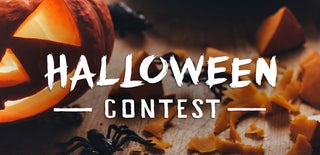Introduction: Halloween Monster House
Inspired by the incredible Christine McConnell, we decided to turn our house into a monster.
This is a surprisingly quick and easy project that creates big impact!
Supplies
sheets of corrugated plastic (like the kind used for political campaign signs)
paint (spray paint suitable for plastic and leftover outdoor house paint)
plastic table cloth (trash bags or other repurposed plastic would work as well)
2 x 1 wood boards
L brackets
hinge
wood screws and glue
Step 1: Designing Pieces and Preparing Materials
First you need to figure out how to give your house a face.
We took a picture of the front of our house and tried drawing different monster features on it. We settled on making the big window a mouth, with eyes above it and horns on the roof, but we considered other options like making the window a giant cyclops eye.
Once you have a plan, you need to source your materials.
We were fortunate to have scrap lumber on hand, as well as some leftover paint and a used plastic table cloth.
Based on our drawing and the real dimensions of the house, we calculated how much corrugated plastic we would need and purchased the sheets from our local hardware store. If your timing is better than ours, you may be able to luck into some discarded political signs for free.
The corrugated plastic comes in very large sheets, so we cut them down to make it more manageable to transport and work with. Pay attention to the direction of the channels or ribs in the plastic - the pieces are most likely to bend along those lines if not properly supported, so large vertical pieces should have the ribs running up and down.
Step 2: Eyes
An easy way to draw big circles is to use a string tied around a tack at one end and a pen at the other. We used a washable marker when drawing our designs onto the plastic so we could just wipe it off if we weren't happy with it.
The best part of drawing a monster is that you don't have to worry about getting it perfect. If your eyes are not perfect it just adds to the monster's ugly charm.
We drew 5 circles for the eyes and cut the shapes out of the corrugated plastic sheet. To cut the plastic we used a combination of a box cutter and strong scissors.
We masked off the eyelid area and painted it green with spray paint.
Then we painted the pupils with black outdoor house paint.
The finished pieces were screwed onto a wood board the width of the set of eyes. This allowed us to install the eyes as one piece and minimize the number of screws we needed to put into the outside of the house.
Step 3: Teeth
Like the eyes, the teeth were first drawn onto the corrugated plastic and then cut out.
With a staple gun, we stapled each set of teeth to a board slightly longer than the width of our window (which would become the mouth). Screws would also work.
To cover the base of the teeth and create monster gums we wraped the board in plastic table cloth material, stapled in place. Any similar material would work, you could use trash bags or other repurposed plastic.
To provide additional structural support to the large lower teeth, we reinforced them with an additional layer of corrugated plastic sheet with the ribs running in a different direction.
Step 4: Horns
The horns were cut from corrugated plastic.
We spray painted the horns green and then painted on purple stripes with a brush.
On the back side of the horns we glued a piece of scrap wood to provide support against the wind. After the glue dried we also screwed it in place through the plastic.
To the bottom of each piece we added an L bracket.
Step 5: Roof Saddle
We didn't want to have anything screwed into our roof and risk future leaks or damage, so we came up with a plan to have the horns straddle the peak of the roof with a wood saddle.
The saddle was constructed from long boards with a hinge in the middle, and perpendicular boards at the end. The hinge lets the saddle adjust to the angle of the roof and the perpendicular boards prevent the horns from being flipped over by the wind. We painted the saddle dark green to match our roof.
The horns were attached to the sadle at an angle with the L brackets. We angled the horns to maintain the illusion that they are three dimensional when trick-or-treaters approach our house. If we had put them parallel to the front of the house the horns would look obviously 2 dimensional, with the edge exposed, as people walk up to our house from the side.
Step 6: Installation
The monster features were installed with as few screws as possible, screwing through the wood boards the plastic was mounted to and into the wood siding of our house.
The saddle with the horns was put into place on the roof and then we added weights to each end of the saddle to hold it in place.

Runner Up in the
Halloween Contest 2019













